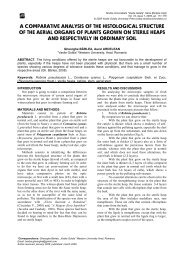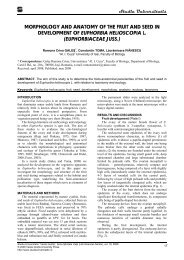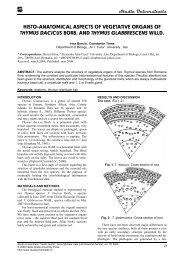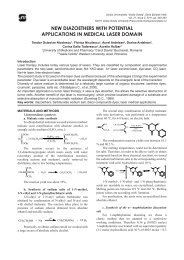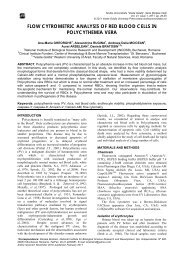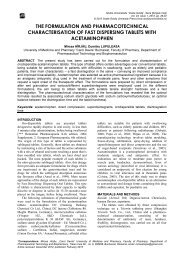THIN-LAYER CHROMATOGRAPHIC STUDIES OF SOME ...
THIN-LAYER CHROMATOGRAPHIC STUDIES OF SOME ...
THIN-LAYER CHROMATOGRAPHIC STUDIES OF SOME ...
You also want an ePaper? Increase the reach of your titles
YUMPU automatically turns print PDFs into web optimized ePapers that Google loves.
Studia Universitatis “Vasile Goldiş”, Seria Ştiinţele Vieţii<br />
Vol. 20, issue 2, 2010, pp. 35-38<br />
© 2010 Vasile Goldis University Press (www.studiauniversitatis.ro)<br />
<strong>THIN</strong>-<strong>LAYER</strong> <strong>CHROMATOGRAPHIC</strong> <strong>STUDIES</strong> <strong>OF</strong> <strong>SOME</strong><br />
ANGIOTENSIN CONVERTING ENZYME INHIBITORS AND THEIR<br />
INCLUSION COMPLEXES WITH β-CYCLODEXTRIN<br />
Laura SBARCEA 1 *, Lucretia UDRESCU 1 , Liana DRAGAN 1 ,<br />
Cristina TRANDAFIRESCU 1 , Codruta SOICA 1 , Marius BOJITA 2<br />
1 “Victor Babes” University of Medicine and Pharmacy, Timisoara, Romania<br />
2 “Iuliu Hatieganu” University of Medicine and Pharmacy, Cluj-Napoca, Romania<br />
ABSTRACT. The aim of this paper is to examine the chromatographic behaviour of some angiotensin<br />
converting enzyme (ACE) inhibitors (lisinopril, fosinopril, zofenopril) under conditions of direct phase thinlayer<br />
chromatography (Kiselgel 60) and their inclusion complexes with β-cyclodextrin using reversed phase<br />
thin-layer chromatography (Kiselgel 60 F254 silaniziert). Binary systems angiotensin converting enzyme<br />
inhibitor-β-cyclodextrin were prepared using the kneading method, in 1:1 molar ratio. The thin-layer<br />
chromatography reveals that the inclusion complexes show lower hRf values compared to the two<br />
components of the inclusion complex, proving that there is an interaction between the active substances and<br />
β-cyclodextrin, due to the formation of the inclusion complexes.<br />
Keywords: ACE-inhibitors, β-cyclodextrin, thin-layer chromatography, inclusion complex, kneading method<br />
INTRODUCTION<br />
The angiotensin-converting enzyme (ACE)<br />
inhibitors represent a class of substances widely used<br />
in the treatment of essential hypertension, congestive<br />
heart failure, diabetic nephropathy and after myocardial<br />
infarction. Their action is based on the inhibition of<br />
ACE, blocking hereby the conversion of angiotensin I<br />
in angiotensin II, a vasoconstrictor biomolecule. The<br />
inhibition of ACE also induces the increase of the<br />
bradikinin, a vasodilatator biomolecule (Ferrar et al.,<br />
2003; Remko, 2007).<br />
Lisinopril, (LIS) (1-[N2-[(S)-1-carboxy-3-<br />
phenylpropil]-L-lysyl]-L-proline dihydrate), belongs to<br />
the class of dicarboxilic-conteining inhibitors and it is<br />
not a pro-drug.<br />
Fosinopril, (FOS) (4-cyclohexyl-1-[2-[(2-methyl-1-<br />
propanoyloxy-propoxy)-(4-phenylbutyl) phosphoryl]<br />
acetyl]-pyrrolidine-2-carboxylic acid, comprises in its<br />
molecule the phosphinic group and it has a high<br />
lipophilicity (Remko, 2007).<br />
Zofenopril, (Z<strong>OF</strong>) [1(S),4(S)]-1(3-mercapto-2-<br />
metil-1-oxopropil) 4 feniltio-L- prolina-S-benzoilester,<br />
is characterized by the presence of sulf in its molecule,<br />
which is responsible for the antioxidant properties of<br />
this compound. It has high lipophilicity (Evangelista<br />
and Manzini, 2005; Subissi et al., 2009).<br />
Fig. 1 presents the chemical structure of the ACE<br />
inhibitors used in this study.<br />
Cyclodextrins (CD) are cyclic oligosaccharides<br />
consisting of six, seven (β-cyclodextrin), eight<br />
glucopyranose units linked by α-(1,4) bonds. The<br />
inclusion of various pharmaceutical substances in their<br />
cavity leads to the improving of some physicochemical<br />
properties of the included compounds, the<br />
enhancing of stability and bioavailability (Loftson et<br />
al., 2005, 2007).<br />
MATERIALS AND METHODS<br />
Materials<br />
• Lisinopril dihydrate ( Medochemie, Limassol,<br />
Cyprus)<br />
• Fosinopril sodium (Terapia–Ranbaxy, Cluj-<br />
Napoca, Romania)<br />
• Zofenopril calcium (Berlin-Chemie Menarini,<br />
Berlin, Germany)<br />
• β-cyclodextrin (β-CD) (Fluka Chemie GmbH,<br />
Germany )<br />
• the substances and the solvents used are of<br />
analytical grade requested by the Romanian<br />
Pharmacopoeia 10th ed (1993) and by European<br />
Pharmacopoeia 5th ed (2004)<br />
• chromatographic plates Kiselgel 60 (Art 5748<br />
DC-Plasstikfolien Kiselgel 60, Merck, Darmstadt,<br />
Germany), 20 X 20 cm, with a width of 0.2 mm<br />
• chromatografic plates Kiselgel 60 F254 (Art 5747<br />
DC-Fertigplatten Kiselgel 60 F254 silanisiert Merck,<br />
Darmstadt, Germany), 20 X 20 cm, with a width of<br />
0.25 mm.<br />
Preparation of inclusion complexes<br />
Binary systems ACE inhibitors – β-CD were<br />
prepared using the kneading method (kneaded<br />
products, KP). For this purpose, the amounts<br />
corresponding to molar ratio 1:1 guest substance:β-CD<br />
were weighed. The obtained mixture was pulverized in<br />
a mortar and then kneaded in a quantity of solvent<br />
equal to the sum of the amounts of ACE inhibitor – β-<br />
CD, until the bulk of solvents evaporated. The solvent<br />
used was: water in the case of LIS, ethanol-water<br />
(50:50, w/w) in the case of FOS and methanol-water<br />
(50:50, w/w) in the case of Z<strong>OF</strong>. After drying at room<br />
temperature, the products were dried in oven at 105˚C.<br />
Afterwards, they were pulverized and sieved (100 μm).<br />
*Correspondence: Laura Sbarcea, “Victor Babes” University of Medicine and Pharmacy, Faculty of Pharmacy, Department of<br />
Pharmaceutical Chemistry, Eftimie Murgu Str. No. 2, 300041, Timisoara, Romania, email: laura_sbarcea@yahoo.com<br />
Article received: February 2010; published: May 2010
Sbarcea L. et al.<br />
O<br />
S<br />
O<br />
N<br />
COO<br />
S<br />
1/2 Ca<br />
Fosinopril natrium<br />
Zofenopril calcium<br />
Lisinopril dihydrate<br />
Fig. 1 Chemical structure of lisinopril, fosinopril and zofenopril<br />
Thin-layer chromatography (TLC)<br />
Planar chromatographic method is mentioned in the<br />
literature when investigating the chromatographic<br />
behaviour of ACE inhibitors (Aleksic et al., 2001;<br />
Odovic et al., 2006) as well as the inclusion complexes<br />
character between them and cyclodextrins (Şoica et al.,<br />
2008; Trandafirescu et al., 2005; Wang et al., 2001).<br />
Chromatographic investigations were performed at<br />
room temperature (22 ± 2˚C), by the method of<br />
ascendant TLC on silica gel and silica gel silanized.<br />
The plates were spotted with 5 μl aliquots of freshly<br />
prepared ethanol solution of FOS, water solution of<br />
LIS and ethanol:chlorhidric acid 1N 1.98: 0.0459 (v/v)<br />
solution of Z<strong>OF</strong>, (about 2 mg/ml), at a distance of 2 cm<br />
between them. The compositions of the mobile phases<br />
used are shown in table 1. The hRf values of the<br />
examined substances were determined.<br />
For the analysis of inclusion complex character of<br />
the active substances with β-cyclodextrin,<br />
chromatographic plates were spotted as shown in table<br />
2. The composition of the solvent systems was: n-<br />
butanol : acetone : water : glacial acetic acid<br />
80:20:10:0.3 (v/v) for LIS and ethyl acetate : water<br />
80:40 (v/v) for Z<strong>OF</strong> and FOS.<br />
The migration distance was 10 cm from the start<br />
line. The chromatographic plates were dried in air after<br />
both development and revelation. Detection was<br />
performed by exposing the plates to iodine vapor. TLC<br />
analysis conditions are characteristic of the guest<br />
substance.<br />
RESULTS AND DISCUSSIONS<br />
According to the dates shown in Table 3, the<br />
compounds characterized by high lipophilicity, FOS<br />
and Z<strong>OF</strong>, present a higher mobility compared to LIS.<br />
The following order of the hRf was recorded: hRf<br />
(FOS) > hRf (Z<strong>OF</strong>) > hRf (LIS). For mobile phases 6<br />
and 7 an inversion of hRf between FOS and Z<strong>OF</strong> was<br />
observed.<br />
Table 1<br />
The composition of the mobile phases used<br />
No. Composition Proportion (v/v)<br />
1 Ethanol<br />
2 Methanol<br />
3 Ethanol : water : chlorhidric acid 1N 89 : 10 : 1<br />
4 Metanol : water : chlorhidric acid 1N 97 : 2 : 1<br />
5 Metanol : water : chlorhidric acid 1N 89 : 10 : 1<br />
6 Ethyl acetate : water: chlorhidric acid 1N 95 : 2 :1<br />
7 Ethyl acetate : ethanol : water : chlorhidric acid 1N 80 : 10 : 2 : 1<br />
8 n-Butanol : water : chlorhidric acid 95 : 2 : 1<br />
9 i-Propanol : water : chlorhidric acid 1N 97 : 2 : 1<br />
10 n-Butanol : Acetone 80 : 20<br />
36<br />
Studia Universitatis “Vasile Goldiş”, Seria Ştiinţele Vieţii<br />
Vol. 20, issue 2, 2010, pp. 35-38<br />
© 2010 Vasile Goldis University Press (www.studiauniversitatis.ro)
Thin-layer chromatographic studies of some angiotensin converting<br />
enzyme inhibitors and their inclusion complexes with β-cyclodextrin<br />
Samples applied on the chromatographic plates<br />
Table 2<br />
Substances Spot 1 Spot 2 Spot 3 Spot 4<br />
Lisinopril 2mg/ml LIS in water 5 mg/ml β-CD in LIS and β-CD 2 mg/ml binary system<br />
distilled water solution forming an LIS-β-CD in distilled<br />
Fosinopril 2mg/ml FOS in ethanol 5 mg/ml β-CD in<br />
distilled water<br />
“in situ” mixture<br />
FOS and β-CD<br />
solution forming an<br />
“in situ” mixture<br />
water<br />
2 mg/ml binary system<br />
FOS-β-CD in distilled<br />
water<br />
Zofenopril 2 mg/ml Z<strong>OF</strong> in ethanol :<br />
chlorhidric acid 1N<br />
1.98:0.0459(v/v)<br />
5 mg/ml β-CD in<br />
distilled water<br />
Z<strong>OF</strong> and β-CD<br />
solution forming an<br />
“in situ” mixture<br />
2 mg/ml binary system<br />
Z<strong>OF</strong>-β-CD in distilled<br />
water<br />
The hRf values of the studied substances on silica gel<br />
Table 3<br />
Substances<br />
Mobile phases used a<br />
1 2 3 4 5 6 7 8 9 10<br />
Lisinopril 3 29 18 28 36 0 0 0 0 0<br />
Fosinopril 84 90 91 92 88 16 71 58 68 55<br />
Zofenopril 77 85 89 87 83 38 79 57 67 24<br />
a The composition of the mobile phases is listed in Table 1<br />
It is known that, the retention of the investigated<br />
substances, under the condition of planar<br />
chromatography on silica gel, is the result of the<br />
hydrogen bond formed with the silanol groups of the<br />
sorbent, dipole-dipole and other electrostatic<br />
interaction (Aleksic et al., 2001).<br />
The bigger adsorption observed for LIS, compound<br />
with diacid function, is probably caused by its capacity<br />
of forming four hydrogen bonds with the silanol group<br />
of the sorbent. The FOS and Z<strong>OF</strong> compound, having 1-<br />
oxo-proline as common structural part, present in their<br />
molecule, beside the oxygen of the carboxyl group<br />
which can form hydrogen bonds, the phosphorus of the<br />
phophinic group and the sulphur of thiolic groups,<br />
which, due to their lower electronegativity, have a<br />
weaker interaction with the sorbent.<br />
Figures 2-4 represent chromatograms of the<br />
investigated ACE inhibitors and their inclusion<br />
complexes with β-CD.<br />
Examination of chromatograms shows that the<br />
active substances migrate over a different distance on<br />
the chromatographic plate, the hRf value being 61 for<br />
LIS, 86 in case of FOS and 92 for Z<strong>OF</strong>, while β-CD<br />
remains at the start line.<br />
For the “in situ” mixture, both the guest substance<br />
and β-CD acts similarly individual compounds, which<br />
rules out the forming of an IC on the chromatographic<br />
plate. In the case of binary systems, ACE inhibitor is<br />
retained by β-CD at the start line, proving that the<br />
active substance is included in β-CD cavity, forming an<br />
inclusion complex.<br />
Fig. 2 TLC of LIS and its IC with β-CD<br />
Fig. 3 TLC of FOS and its IC with β-CD<br />
Studia Universitatis “Vasile Goldiş”, Seria Ştiinţele Vieţii<br />
Vol. 20, issue 2, 2010, pp. 35-38<br />
© 2010 Vasile Goldis University Press (www.studiauniversitatis.ro)<br />
37
Sbarcea L. et al.<br />
38<br />
Fig. 4 TLC of Z<strong>OF</strong> and its IC with β-CD<br />
CONCLUSIONS<br />
Thin-layer chromatography has proved to be a<br />
simple, rapid and inexpensive method useful in<br />
analyses of ACE inhibitors and their inclusion<br />
complexes whit β-CD.<br />
Binary compounds obtained by kneading method<br />
have a chromatographic behaviour which differs from<br />
that of the active substances, the hRf value of<br />
complexes being smaller than that of the guest<br />
molecules. Inclusion complex character of the<br />
complexation products has been also pointed out using<br />
this method.<br />
REFERENCES<br />
Aleksic M, Agbaba D, Baosic R, Milojkovic-Opsenica<br />
D, Tesik Z, Thin-layer chromatography of<br />
several antihypertensive drugs from the group<br />
of angiuotensin converting enzyme inhibitors. J.<br />
Serb. Chem. Soc., 2001,66 (1), 39-44<br />
Aleksic M, Agbaba D, Milojkovic-Opsenica D, Tesik<br />
Z, Salting-out thin-layer chromatography of<br />
some angiotensin converting enzyme inhibitors<br />
on different sorbents. Chromatographia<br />
Supplement 53, 2001, S-442- S-444<br />
Evangelista S, Manzini S, Antioxidant and<br />
cardioprotective properties of sulphydryl<br />
angiotensin-converting enzyme inhibitor<br />
zofenopril. Journal of international medical<br />
research, 2005, 33 (1), 42-54<br />
Ferrar R, Guardigli G, Mele D, Valgimigli M, Ceconi<br />
C, Myocardial ischemia: new evidence for<br />
angiotensin - converting enzyme inhibition.<br />
European Heart Journal Supplements 2003, 5<br />
(Supplement E), E11 – E17<br />
Loftson T, Duchêne D, Cyclodextrins and their<br />
pharmaceutical application. Int. J. Pharm., 2007,<br />
329 (1-2), 1-11<br />
Loftson T, Hreinsdottir D, Másson M, Evaluation of<br />
cyclodextrin solubilization of drugs. Int. J.<br />
Pharm., 2005, 302, 18-28<br />
Odovic J, Stojimirovic B, Aleksic M, Milojkovic-<br />
Opsenica D, Tesic Z, Reversed - phase thin –<br />
layer chromatography of some angiotensin<br />
converting enzyme (ACE) inhibitors and their<br />
active metabolites. J. Serb. Chem. Soc., 2006,<br />
71 (6), 621 - 628<br />
Remko M, Acidity, Lipophilicity, Solubility,<br />
Absorbtion, and Polar Surface Area of Some<br />
ACE Inhibitors. Chem. Pap. 2007, 61 (2) 133-<br />
141<br />
Subissi A, Evangelista S, Giachetti A, Preclinical<br />
profile of zofenopril: an angiotensin converting<br />
enzyme inhibitor with pelicular cardioprotective<br />
properties. Cardiovascular Drug Reviews, 1999,<br />
17 (2), 115 – 133<br />
Şoica C, Gyeresi A, Dehelean C, Peev C, Aigner Z,<br />
Kata M, Thin-layer chromatography as<br />
analytical method for inclusios complexis of<br />
some diuretics with cyclodextrins. Farmacia,<br />
2008, vol. LVI, 1, 75-82<br />
Trandafirescu C, Gyéresi Á, Kata M, Aigner Z,<br />
Szabadai Z, Studiu privind efectul betaciclodextrinei<br />
asupra hidrosolubilităţii<br />
bifonazolului. Farmacia, 2005, LIII, 5, 83-93<br />
Wang X, Pan J, Shuang S, Thin layer chromatographic<br />
study on inclusion complex formation between<br />
cyclodextrin and some flavonoids, Analytical<br />
letters, 2001, 34 (2), 239-245<br />
*** Farmacopeea Românǎ, Ed a-X-a, Ed Medicala,<br />
Bucuresti, 1993<br />
*** European Pharmacopoea, 5th Ed., 2004, Council<br />
of Europe, Strasbourg<br />
Studia Universitatis “Vasile Goldiş”, Seria Ştiinţele Vieţii<br />
Vol. 20, issue 2, 2010, pp. 35-38<br />
© 2010 Vasile Goldis University Press (www.studiauniversitatis.ro)



